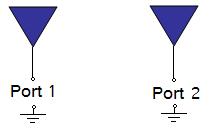S-Parameters
|
S-parameters describe the input-output relationship between ports (or terminals) in an electrical system. For instance, if we have 2 ports (intelligently called Port 1 and Port 2), then S12 represents the power transferred from Port 2 to Port 1. S21 represents the power transferred from Port 1 to Port 2. In general, SNM represents the power transferred from Port M to Port N in a multi-port network.
A port can be loosely defined as any place where we can deliver voltage and current. So, if we have a communication system with two radios (radio 1 and radio 2), then the radio terminals (which deliver power to the two antennas) would be the two ports. S11 then would be the reflected power radio 1 is trying to deliver to antenna 1. S22 would be the reflected power radio 2 is attempting to deliver to antenna 2. And S12 is the power from radio 2 that is delivered through antenna 1 to radio 1. Note that in general S-parameters are a function of frequency (i.e. vary with frequency). As an example, consider the following two-port network:

In the above Figure, S21 represents the power received at antenna 2 relative to the power input to antenna 1. For instance, S21=0 dB implies that all the power delivered to antenna 1 ends up at the terminals of antenna 2. If S21=-10 dB, then if 1 Watt (or 0 dB) is delivered to antenna 1, then -10 dB (0.1 Watts) of power is received at antenna 2. If an amplifier exists in the circuitry, then S21 can show gain (i.e. S21 > 0 dB). This means that for 1 W of power delivered to Port 1, more than 1 W of power is received at Port 2.
In practice, the most commonly quoted parameter in regards to antennas is S11. S11 represents
how much power is reflected from the antenna, and hence is known as the reflection coefficient (sometimes written
as gamma:
As an example, consider the plot of S11 in the following figure:

The above would typically be measured using a Vector Network Analyzer (VNA), which can plot S11. The above figure implies that the antenna radiates best at 2.5 GHz, where S11=-10 dB. Further, at 1.5 GHz the antenna will radiate virtually nothing, as S11 is close to 0 dB (so all the power is reflected). The antenna bandwidth can also be determined from the above figure. If the bandwidth is defined as the frequency range where S11 is to be less than -6 dB, then the bandwidth would be roughly 1 GHz, with 3 GHz the high end and 2 GHz the low end of the frequency band.
This page on S-parameters related to antennas is copyrighted. Copyright antenna-theory.com, 2008-2015.
|
 or return loss.
If S11=0 dB, then all the power is reflected
from the antenna and nothing is radiated. If S11=-10 dB, this implies that if 3 dB of power is delivered
to the antenna, -7 dB is the reflected power. The remainder of the power was "accepted by" or deliverd to the antenna. This
accepted power is either radiated or absorbed as losses within the antenna. Since antennas
are typically designed to be low loss, ideally the majority of the power delivered to the antenna
is radiated. See also
or return loss.
If S11=0 dB, then all the power is reflected
from the antenna and nothing is radiated. If S11=-10 dB, this implies that if 3 dB of power is delivered
to the antenna, -7 dB is the reflected power. The remainder of the power was "accepted by" or deliverd to the antenna. This
accepted power is either radiated or absorbed as losses within the antenna. Since antennas
are typically designed to be low loss, ideally the majority of the power delivered to the antenna
is radiated. See also